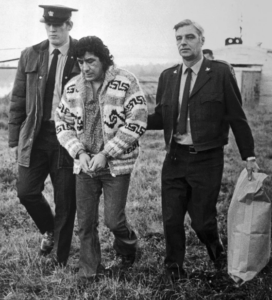Art, at times, speaks volumes. In the case of Gina Lee Robbins’ latest art exhibition, messages are whispered and shouted from her work. It consists of two separate installations, “Encounters” and “Relics,” which together make up “Tangled Up in Blue,” which is described as a meditation on Chicago-area encounters with law enforcement during the past 22 years that ended with a fatality. It is on view at Waubonsee Community College’s Sugar Grove Campus.
“When I got the news of 13-year-old Adam Toledo’s murder in Chicago last March, it went through me like an arrow,” Robbins says in her artist statement. In his photo, she saw a child reminiscent of children she has taught and her sons’ soccer teammates and classmates. This made her want “to understand how it is that interactions with law enforcement can have such lethal results.”
“Generally, when an incident really upsets, or confuses me, I seek out data to make sense of what seems completely senseless,” said Robbins, an Oak Park resident for 20 years who moved to Forest Park this summer. “I wanted to understand why the use of deadly force would be necessary, in this case and in general. I looked at accounts of law officers killed on duty, and in my research came across an organization that collects media reports of fatal encounters in the presence of law enforcement.”
Robbins turned to the nonprofit fatalencounters.org, which works to create “an impartial, comprehensive and searchable national database of people killed during interactions with police,” according to their website.
She pored over every story of a life lost in the presence of law enforcement, ultimately focusing on Cook County in this century.
“These included fatalities due to officers using deadly force, officers using less than deadly force, bystanders or pursued suspects being killed in a vehicular pursuit, suicides and incidents of fatal violence or vehicular homicide — often due to DUI — by off-duty officers,” she said.
“Encounters is the result of my journey through this data,” Robbins’ says in her statement. “As I read each story, I rolled a small wad of porcelain clay in my hands. When I finished, I said the deceased’s name aloud, and made a fist, squeezing the clay in my palm. I repeated this process for all 624 individuals whose stories were reported.” She also wrote each name in a notebook.
In a final touch before firing, Robbins rubbed cobalt carbonate onto her hands and “loosely touched” the clay wads, which left remnants of blue after firing. For the installment, the individual pieces, each about 2.5 inches long, were strung on steel wire by the year each incident occurred. The wires are draped from the ceiling in the exhibit space, approximately 14 x 8 feet, suspended from a height of 8-9 feet.
“Relics is a more qualitative look at those stories, focusing on what might have been left behind by some of these victims,” Robbins said.
Her artist statement fills in the details. “I collected 13 items that were significant to the stories reported: a box cutter, fork, pellet gun, spent firecrackers, cardboard sign, beach ball, knife, automobile debris, pizza box, dust mop, screwdriver, stroller wheel and sleeping bag. I shrouded each element individually, using cotton sheets and burlap that I had hand-dyed and torn. I then bound them with yarn and military thread in various shades of blue, working reclaimed 9 mm bullet casings into those whose stories involved the use of deadly force.”
The resulting elements in the display, each measuring 5-40 inches, placed on the floor of the exhibit, look bound, some evoking mummification. All are stained with police blue. Bullet casings haunt the scene.
Robbins found working on this project differed from some of her other artmaking.
“This project was quite draining for me,” she said. “I have completed many other sculptures and installations that involved repetitive action, even some that also used sculptural elements to quantify data. But with this project, I really focused on the qualitative aspects behind the numbers. … During the hours it took to create the pieces for both works, I couldn’t focus on anything but the stories and individuals affected. I couldn’t listen to background music, podcasts or audiobooks, which are all usual accompaniments to my art making.
“Although this is a representation of my very personal processing of these stories, I am sharing them in hopes that someone else might be equally impressed by the sheer numbers, or have their curiosity piqued by the ‘relics,’ leading them to also look a little more closely at the data and join me in questioning this system that is meant to keep us feeling safe,” she said. “We as a species are such innovative problem-solvers. There has to be a better way.”
See Tangled Up in Blue through Oct. 14, Dickson Art Project Space, Waubonsee Community College’s Sugar Grove Campus, Route 47 at Waubonsee Dr., Sugar Grove. The exhibit is viewable at all hours through the windows that enclose the project space.




